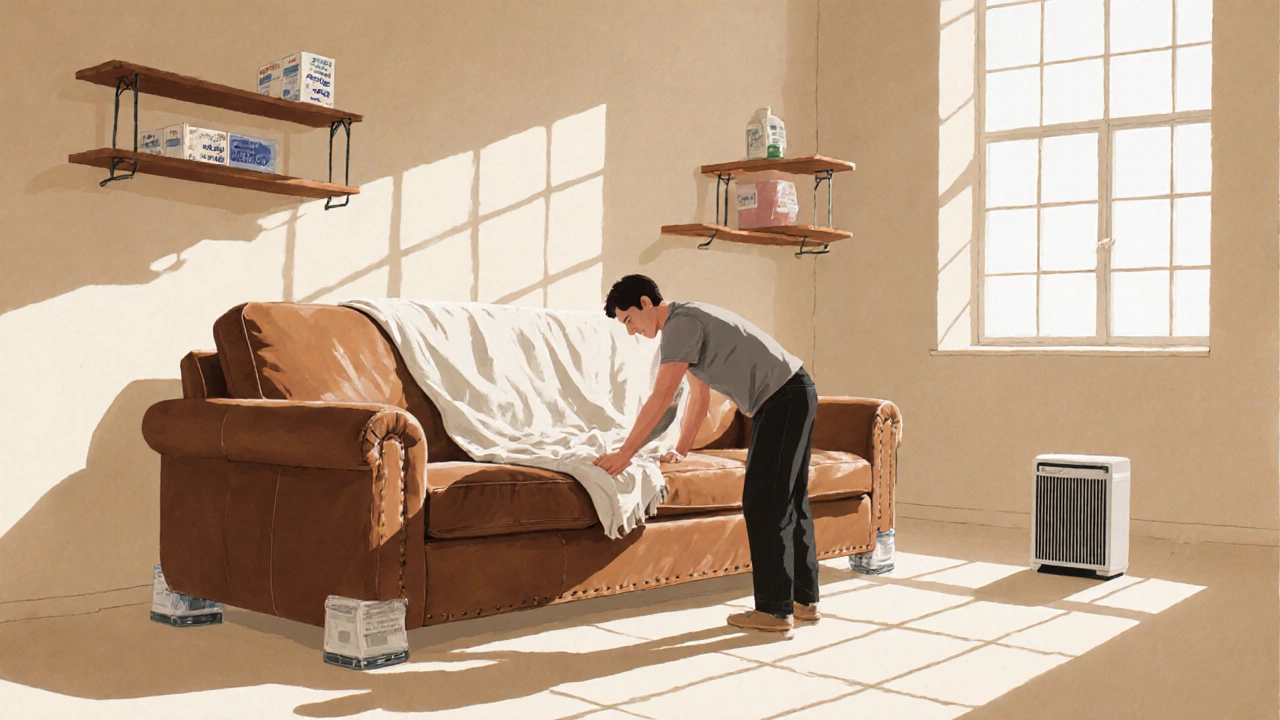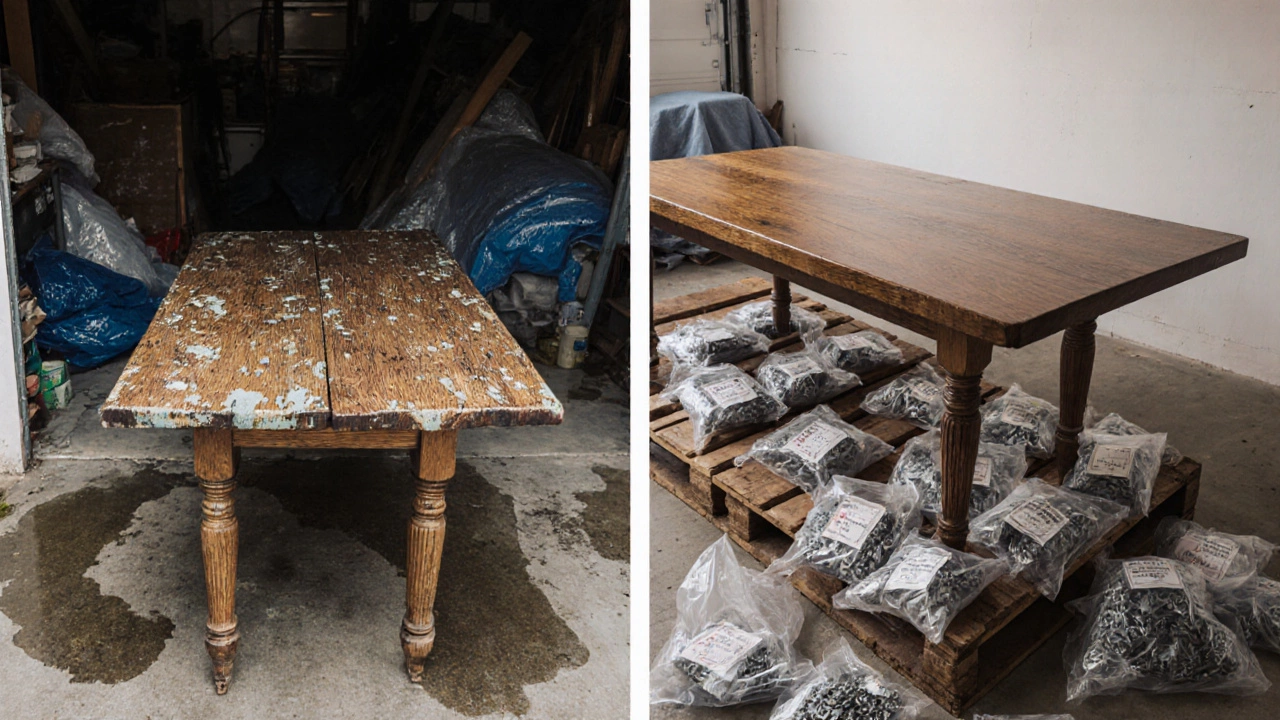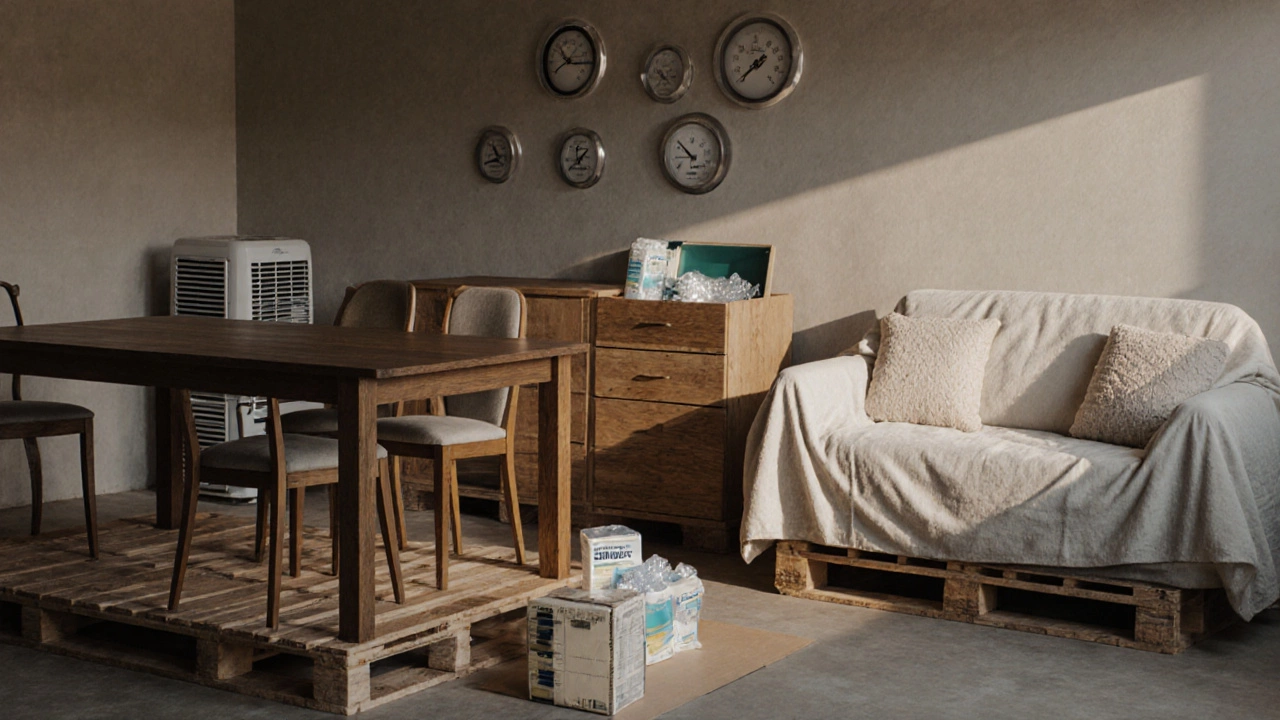Furniture Storage Suitability Calculator
Check your storage conditions below
Storing furniture isn’t just about tossing it into a garage or basement. If you do it wrong, you could end up with warped wood, stained fabric, rusted metal, or worse - a piece you loved now ruined beyond repair. Whether you’re moving, renovating, or just clearing space, how you store your furniture matters more than you think.
Know What You’re Working With
Not all furniture is made the same. A solid oak dining table handles storage differently than a particleboard bookshelf. Leather sofas need air. Upholstered chairs can mildew. Metal legs rust if they touch concrete. You can’t treat everything the same way.Start by identifying the materials:
- Wood - Solid wood is durable but sensitive to humidity. Engineered wood (like MDF or particleboard) swells easily.
- Upholstery - Fabric soaks up moisture. Leather cracks if it dries out.
- Metal - Prone to rust, especially in damp places.
- Wicker and rattan - Brittle in dry heat, moldy in damp air.
Knowing this helps you pick the right storage spot and prep each piece correctly.
Clean Everything Before You Store It
Dirt and dust aren’t just ugly - they’re abrasive. They trap moisture, attract pests, and stain over time. Never store something dirty.For wood furniture, wipe down surfaces with a damp cloth and mild soap. Dry immediately. Use a wood-specific cleaner if you have one. Don’t use vinegar or ammonia - they strip finishes.
For upholstery, vacuum thoroughly. Use a fabric cleaner designed for your material. Test it on a hidden spot first. For leather, use a pH-balanced leather conditioner. It keeps the material supple and prevents cracking.
Remove cushions, drawers, and legs if possible. Store them separately. Legs on tables and chairs often get damaged when stacked. Keep screws and hardware in labeled ziplock bags taped to the frame.
Choose the Right Storage Space
Not every storage spot is created equal. Your garage? Too hot in summer, too cold and damp in winter. Your basement? Likely to have moisture issues. Your attic? Dry but full of temperature swings.The ideal storage location:
- Temperature-controlled - Between 55°F and 75°F. Avoid places that drop below freezing or rise above 85°F.
- Low humidity - Aim for 40-50% relative humidity. Above 60% invites mold. Below 30% dries out wood and leather.
- Well-ventilated - Airflow prevents stale smells and mildew.
- Off the floor - Use pallets or risers. Concrete and dirt wick moisture up into your furniture.
If you’re using a self-storage unit, go for climate-controlled. It costs more, but it’s worth it for quality pieces. A $500 sofa can turn into a $50 liability if stored in a non-climate-controlled unit.
Protect Your Furniture the Right Way
Covering furniture seems simple - just throw a sheet over it, right? Wrong. A cotton sheet traps moisture. Plastic wrap suffocates wood and fabric.Use breathable covers:
- Moving blankets - Great for wood and metal. They cushion and allow airflow.
- Cotton drop cloths - Better than plastic for upholstery. They don’t trap condensation.
- Furniture covers with vents - Sold at storage supply stores. Designed specifically for long-term protection.
Never use plastic tarps or garbage bags. They create a greenhouse effect - sweat builds up inside, and moisture gets trapped. You’ll wake up to mold spots you didn’t even know were there.
For tables and desks, use foam corner protectors. Stack items carefully. Put heavier pieces on the bottom. Never stack upholstered chairs on top of each other - the weight crushes the frames.

Store Furniture Upright and Off the Ground
Laying a sofa flat on its back for months? That’s a fast way to ruin the springs and cushion shape. Same with dressers - storing them on their side can warp the joints.Here’s how to position things:
- Tables and desks - Stand upright. Place a moving blanket under the legs to lift them off the floor.
- Sofas and chairs - Keep upright. Use furniture sliders or blocks to tilt them slightly back so air circulates underneath.
- Dressers and cabinets - Stand upright. Leave drawers slightly open (about an inch) to prevent warping. If you must remove drawers, store them flat.
- Beds - Disassemble the frame. Store the headboard and footboard upright against a wall. Mattresses should be stored flat on a raised platform - never on their side.
Always leave space between pieces. Crowding traps moisture and makes it harder to inspect for damage later.
Check on Your Stuff Regularly
Set a reminder. Every 60 to 90 days, visit your storage space. Even if you’re not moving soon, a quick check prevents big problems.Look for:
- Mold or mildew - Especially in corners or under covers.
- Moisture on wood - Warping or dark spots.
- Odors - Musty smells mean mold is growing.
- Pests - Tiny holes in wood? Look for powder-like dust - that’s termites.
If you spot moisture, move the piece to a drier spot. If you see pests, call a professional. Don’t wait. A small infestation can spread fast.
What Not to Do
Here are the most common mistakes people make:- Storing in garages or basements without climate control - Too risky for anything valuable.
- Using plastic wrap - Traps moisture like a sauna.
- Leaving items in direct sunlight - UV rays fade fabric and dry out wood finishes.
- Stacking heavy items on upholstered pieces - Crushes springs and frames.
- Forgetting to clean - Dirt turns into stains over time.
One person stored a walnut dining table in a damp garage for six months. When they pulled it out, the legs were swollen and the finish peeled off. It cost $1,200 to restore. A $20 dehumidifier would’ve saved it.

Long-Term Storage Tips
If you’re storing furniture for more than six months:- Use silica gel packs inside drawers and cabinets to absorb moisture.
- Place a small dehumidifier in the storage unit - even a portable one works.
- Rotate cushions on sofas every few months to prevent permanent indentations.
- Apply a thin coat of paste wax to wood surfaces every 6 months - it seals and protects.
- Keep a checklist: item, condition, storage location, last check date.
Some people use furniture storage services that offer inventory tracking and climate monitoring. It’s pricier, but if you’re storing heirlooms or expensive pieces, it’s worth the peace of mind.
When to Just Let Go
Not every piece deserves to be saved. If your furniture is already damaged, outdated, or low quality, storing it just delays the inevitable.Ask yourself:
- Is it worth the cost of storage?
- Will I actually use it again?
- Does it hold real sentimental value, or am I just keeping it out of guilt?
If the answer is no, donate it. Sell it. Recycle it. There’s no shame in letting go. The space you free up - mentally and physically - is more valuable than a dusty chair you haven’t sat on in five years.
Final Checklist
Before you seal up your furniture for storage:- ✅ Clean every surface - no dust, no stains.
- ✅ Disassemble if possible - legs, drawers, shelves.
- ✅ Wrap in breathable fabric - never plastic.
- ✅ Elevate off the floor - use pallets or risers.
- ✅ Store upright - never flat on sofas or dressers.
- ✅ Control humidity - use dehumidifiers or silica packs.
- ✅ Leave space between items - for airflow and access.
- ✅ Label everything - what’s inside, where it goes.
- ✅ Schedule check-ins - every 60-90 days.
Proper storage doesn’t take much effort - just consistency. Do it right, and your furniture will be ready to use again, just like new.
Can I store furniture in my garage?
You can, but only if it’s climate-controlled and off the floor. Most garages get too hot in summer and too damp in winter. Solid wood, leather, and upholstery will suffer. If you must use a garage, use a dehumidifier, raise items on pallets, and cover with breathable moving blankets.
Should I use plastic wrap to cover furniture?
No. Plastic traps moisture, creating condensation that leads to mold, mildew, and warping. Even if the furniture looks dry on the outside, moisture builds up underneath. Use cotton drop cloths or breathable moving blankets instead.
How do I prevent wood furniture from cracking?
Keep humidity between 40% and 50%. Dry air pulls moisture out of wood, causing cracks. Use a humidifier if your storage space is too dry. Apply paste wax every 6 months to seal the surface. Avoid direct sunlight and heat sources.
Can I store a mattress in a storage unit?
Yes, but never on its side. Store it flat on a raised platform, covered with a breathable mattress bag. Moisture and pressure can ruin the internal springs or foam. Avoid basements and garages - opt for climate-controlled storage.
How long can I safely store furniture?
With proper care, furniture can be stored for years - even decades. The key isn’t time, it’s conditions. Temperature-controlled, dry, clean, and ventilated storage keeps pieces in good shape. Check every 2-3 months to catch problems early.
What’s the best way to store a leather sofa?
Clean it with a leather conditioner first. Don’t let it dry out. Store it upright in a cool, dry place with 40-50% humidity. Cover it with a cotton sheet - never plastic. Check every 60 days for cracks or stiffness. Recondition if needed.

